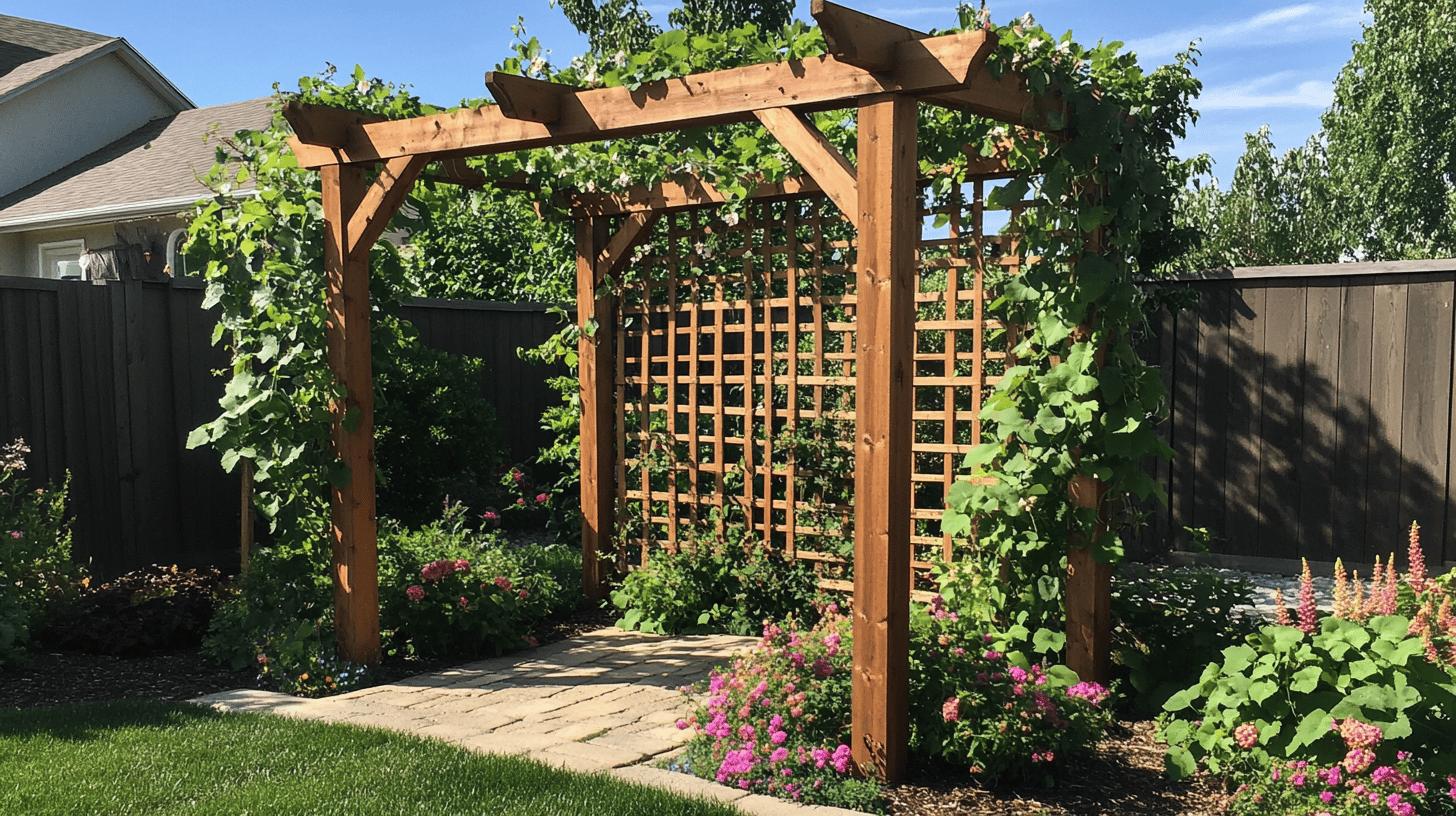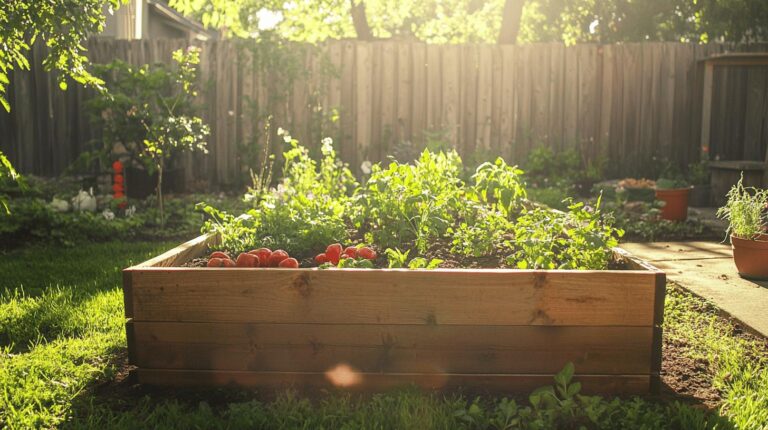The Ultimate Guide to Garden Arbors: Transform Your Backyard Without Breaking the Bank
Have you ever wondered how a simple structure could completely transform your backyard? An arbor garden trellis might just be the secret ingredient you’ve been missing. Many backyard enthusiasts are discovering that a well-placed arbor doesn’t just serve as a support for climbing plants, but it also stands out as a striking focal point, enhancing the overall aesthetics of the space. In this article, we’re diving into the essentials of choosing the perfect arbor garden trellis for your backyard. Whether you want to create inviting entrances or add structure and charm, we’ll explore how to achieve your vision effortlessly.
Choosing the Perfect Arbor Garden Trellis for Your Backyard
An arbor garden trellis can be the crown jewel of your backyard, serving as a striking focal point that draws the eye and invites exploration. These structures not only support the growth of climbing plants but also add architectural interest to your garden. Picture an arbor arching over a pathway, laden with blooming roses or vibrant clematis. Such an addition can turn a simple walk through your garden into an enchanting journey, enhancing the overall aesthetic appeal and creating a sense of tranquility and escape.
Beyond their visual allure, arbors contribute to the functionality of your backyard by defining spaces and creating natural gateways. They can frame a view, lead into a new garden area, or provide a charming entryway to your home. With climbing plants weaving through their structure, arbors can also offer a degree of shade and privacy. This combination of beauty and utility makes them an invaluable addition to any backyard, transforming everyday walks into moments of serenity.
When selecting the right arbor garden trellis for your backyard, consider these factors:
- Style: Choose a design that complements your home’s architecture, whether traditional, rustic, or modern.
- Size: Ensure the arbor fits the scale of your space and the height of your plants.
- Material: Consider durability and maintenance, opting for wood, metal, or vinyl based on your climate.
- Functionality: Decide if it will support heavy climbers or serve primarily as a decorative element.
- Location: Position it to enhance views or define garden areas without obstructing pathways.
The right arbor can elevate your backyard’s aesthetics, turning it into a personal sanctuary. Its presence in your garden not only adds structure and height but also enhances the natural beauty, inviting you and your guests to linger and enjoy the outdoor space.
Inspiring Garden Trellis Ideas for Your Backyard

A trellis can be the secret ingredient to revitalizing your backyard decor, adding both structure and charm. These versatile structures can transform any garden space, offering support to climbing plants while enhancing the visual appeal of your outdoor area. Whether you’re looking to make a bold statement or subtly complement your existing garden, creative trellis designs provide countless opportunities to personalize your backyard. From vibrant colors to intricate patterns, the right trellis can elevate your garden, making it a place where beauty and functionality meet.
Arched Garden Paths
Arched garden paths are more than just practical walkways; they are an invitation to explore the natural beauty that surrounds them. By incorporating arched trellises into your garden paths, you create a dynamic entryway that encourages movement and curiosity. As plants climb and twine around the arches, they form a living tunnel of greenery and blooms, drawing the eye forward and creating a sense of continuity and flow. These paths not only guide visitors through your garden but also add an element of surprise and delight, making each journey a memorable experience.
Standalone Arbors
Standalone arbors with elegant columns can be stunning focal points in any garden. These structures offer a sense of grandeur and permanence, serving as both a visual anchor and a functional support for climbing plants. By choosing an arbor with intricate detailing or a unique shape, you can create a centerpiece that reflects your personal taste and enhances the overall aesthetic of your garden. Whether nestled among flower beds or positioned at a key viewpoint, standalone arbors can elevate the elegance of your outdoor space.
Here are some creative trellis ideas to inspire your backyard transformation:
- Bold-colored arbors: Paint your arbor in a vibrant hue to create a striking focal point that stands out against the greenery.
- Decorative lattice patterns: Incorporate intricate lattice work into your trellis design for a touch of sophistication and texture.
- Mixed-materials trellises: Combine wood and metal for a contemporary look that blends natural and industrial elements.
- Integrated seating: Design a trellis with built-in benches, providing a cozy spot to relax and enjoy the garden.
- Multi-level trellises: Utilize varying heights to add depth and dimension, encouraging plants to grow at different levels.
With these ideas, your garden trellis can become more than just a plant support—it can be a statement piece that transforms your backyard into an elegant and inviting retreat.
DIY Garden Trellis: Building Cost and Materials
Crafting your own garden trellis is a rewarding project that combines creativity with practicality, offering a cost-effective solution to enhance your backyard. DIY trellises are not only budget-friendly but also provide the flexibility to customize designs that suit your garden’s unique needs. Building your own trellis can save money, with options like constructing a garden arch trellis for just $30 using economical metal cattle panels. These panels are not only affordable but also easy to assemble, disassemble, and relocate, making them a versatile choice for any garden enthusiast.
Here’s a list of essential materials and tools you’ll need for your DIY garden trellis project:
- Metal cattle panels
- Screws
- Saw
- Drill
- Measuring tape
Selecting durable materials is crucial to ensure that your garden trellis withstands the elements and lasts for years. Metal cattle panels are an excellent choice due to their strength and resilience, providing a sturdy framework for climbing plants. By investing in quality materials, you can enjoy a long-lasting structure that supports your garden’s growth and enhances its aesthetic appeal.
Step-by-Step Guide to Installing a Garden Arbor Trellis
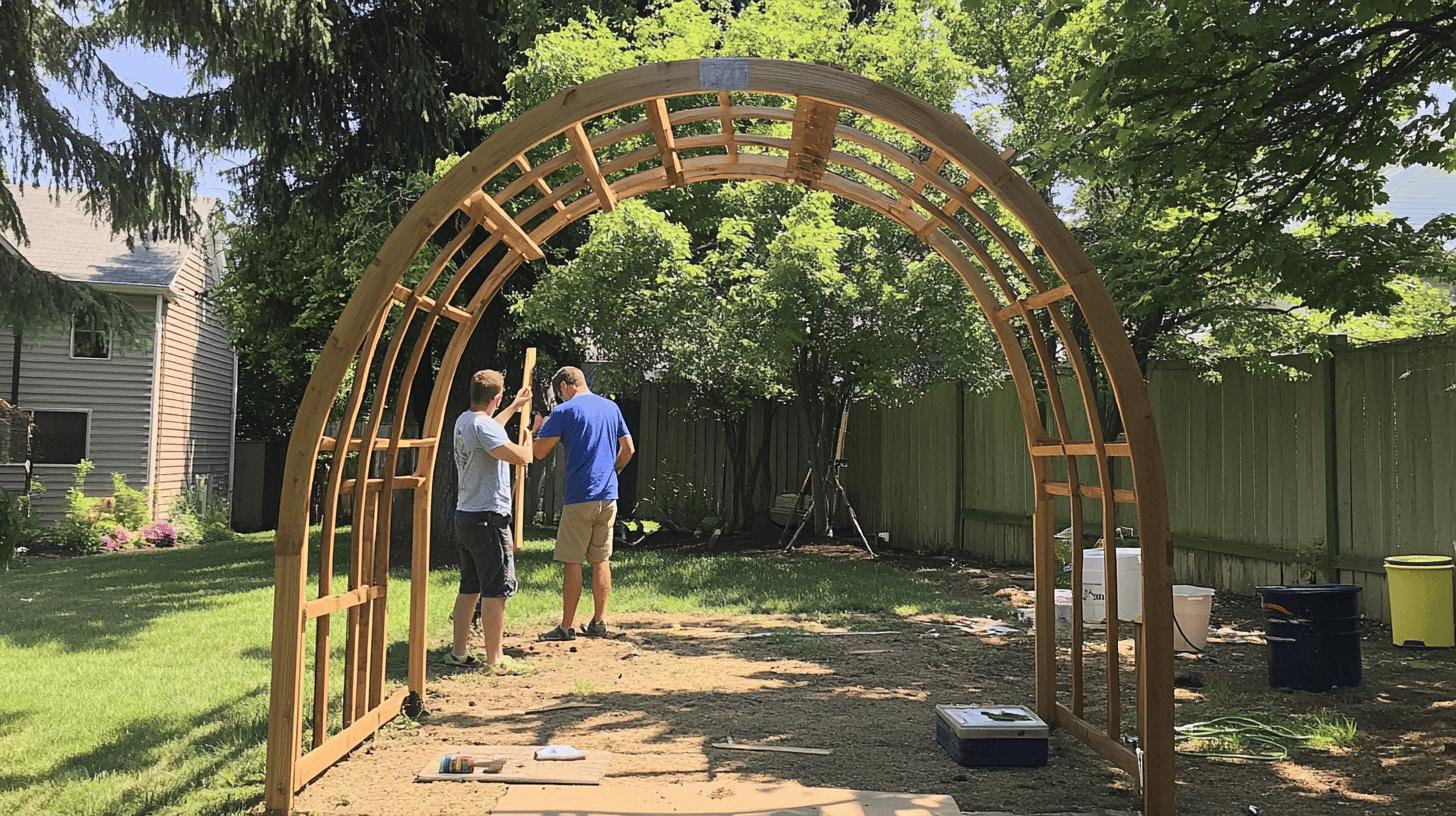
Installing a garden arbor trellis might sound daunting, but with the right approach, it’s a task that’s both manageable and rewarding. The assembly of an arched trellis is straightforward, especially when you have a friend to lend a hand. Vertical gardening not only maximizes space but also simplifies the setup by allowing your plants to climb naturally, making your outdoor area more vibrant.
Planning the Design
Before diving into the installation, take some time to plan the design of your arbor trellis. Start by selecting the perfect site, considering factors like sunlight, soil conditions, and proximity to other garden features. This choice will influence the style that best suits your space—be it rustic, modern, or traditional. Ensuring your trellis complements the existing backyard structures enhances the overall aesthetic appeal and functionality of your garden.
Preparing Materials
Once you’ve settled on a design, gather your materials and tools. You’ll need to cut and organize components to fit the intended space. Essential tools include a saw for cutting wood or metal pieces, a drill for securing parts, and measuring tape to ensure precision. Metal cattle panels are a popular choice for their durability and ease of use, making them ideal for supporting climbing plants.
Assembling the Trellis
With everything ready, it’s time to assemble your garden arbor trellis. Begin by erecting the main structure, securing the posts firmly into the ground. Use your drill to connect the horizontal beams, ensuring they are level for a stable framework. For an arched design, gently bend the top panels and attach them securely to the vertical supports. It’s here that an extra set of hands can be invaluable, providing both support and alignment as you finalize the assembly.
After assembling your trellis, securing it in place is crucial for stability and longevity. Check that all connections are tight, and consider anchoring the posts further with concrete if needed, especially in areas prone to strong winds. This ensures your trellis remains a sturdy and beautiful addition to your garden, ready to support your climbing plants and elevate your backyard’s appeal.
Selecting the Best Climbing Plants for Your Trellis
Climbing plants are the unsung heroes of any garden trellis, turning a simple structure into a lush, green masterpiece. They not only add vertical interest and texture but also provide a natural way to create privacy and shade. As these plants wind and weave their way up the trellis, they can transform an ordinary backyard into a vibrant, inviting space. The beauty of climbing plants lies in their versatility, allowing gardeners to experiment with different species to find the perfect fit for their trellis. With the right selection, your trellis can become a living tapestry, showcasing an array of colors and fragrances that delight the senses.
Here are five recommended plant species perfect for trellis growth:
- Climbing Roses: Known for their stunning displays, they bring a classic beauty and a burst of color to any trellis.
- Clematis: This versatile climber offers a range of colors and bloom sizes, adding a touch of elegance and flair.
- Honeysuckle: With its sweet fragrance and colorful blooms, it attracts pollinators and adds a charming scent.
- Wisteria: Offers dramatic, cascading blooms that create a fairy-tale atmosphere and provide excellent shade.
- Morning Glory: Known for its rapid growth and vibrant flowers, it creates a dynamic and colorful display.
The magic of climbing plants lies in their ability to enhance the appearance of a trellis while offering practical benefits like shade. As these plants grow, they form a natural canopy, providing shelter from the sun and reducing heat in outdoor spaces. By choosing the right climbing plants, you can elevate the aesthetic and comfort of your backyard, creating a serene and shaded retreat.
Maintaining Your Arbor Garden Trellis
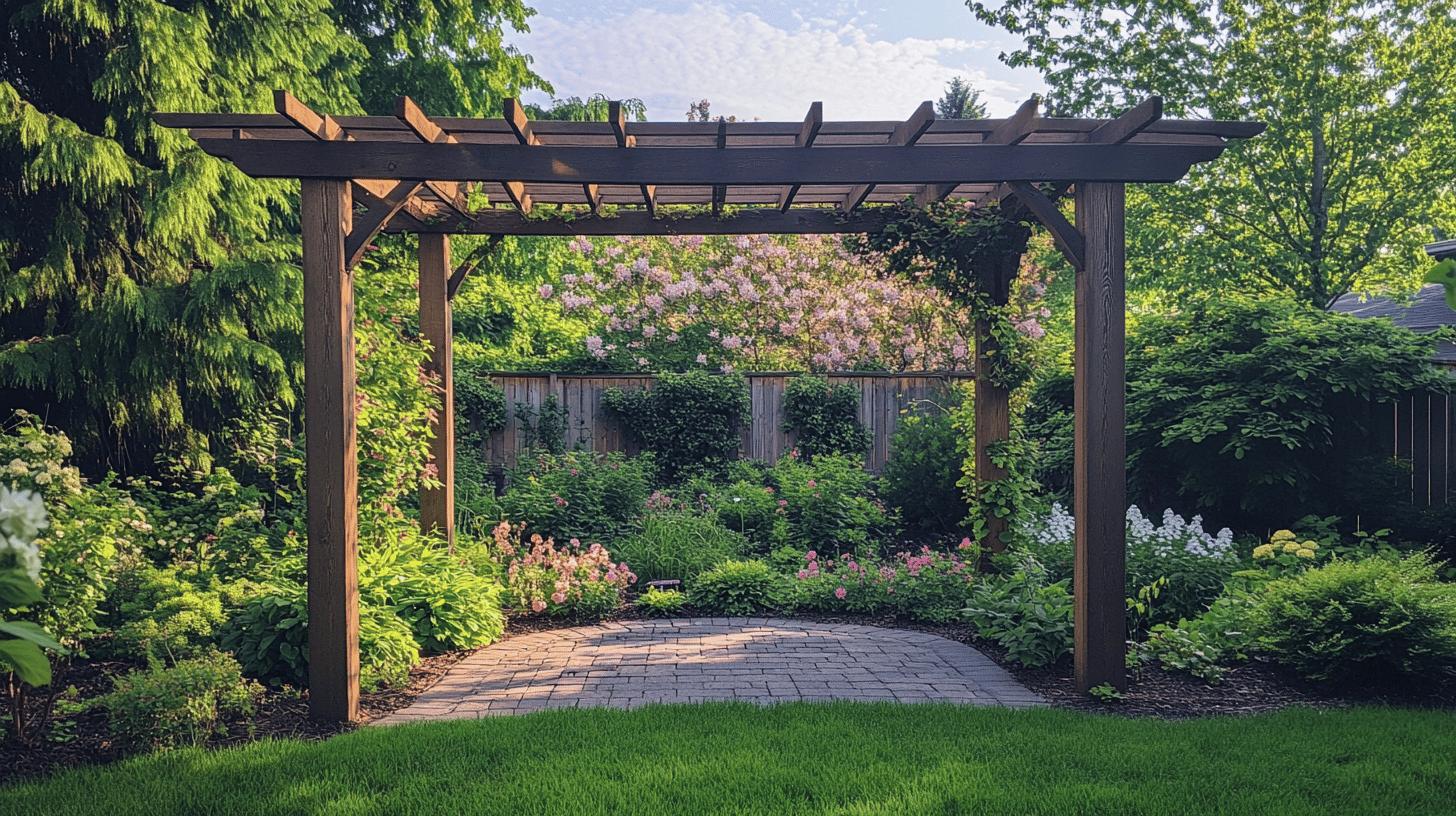
Regular maintenance is crucial for keeping your arbor garden trellis in top condition, ensuring it remains a beautiful and functional part of your backyard for years to come. By dedicating time to upkeep, you can prevent the wear and tear that comes with exposure to the elements and the growth of climbing plants. This not only preserves the trellis’s aesthetic appeal but also supports the health and vibrancy of the plants it holds. A well-maintained trellis acts as a sturdy backbone, allowing your garden to flourish and making it a true focal point.
Here are four key maintenance tasks to keep your trellis in excellent shape:
- Cleaning: Regularly wash the trellis to remove dirt, algae, and mildew, which can affect both the structure and plant health.
- Inspecting for Damage: Check for signs of wear, such as rust on metal parts or rot in wooden components, and address them promptly to prevent further issues.
- Trimming Plants: Prune climbing plants to prevent them from becoming too heavy and overwhelming the structure, ensuring they have enough support.
- Reinforcing Supports: Tighten or replace any loose or weakened connections, especially if supporting weeping plants that require robust support.
Proper maintenance not only extends the life of your trellis but also enhances its overall appearance, making your backyard more inviting. By staying vigilant with these tasks, you ensure that your arbor garden trellis remains a durable and attractive feature, providing a practical and stylish solution for both plant growth and outdoor decor.
Integrating Arbors into Backyard Landscaping
Arbors are more than just a decorative element; they serve as pivotal focal points in backyard landscaping. These structures can transform an ordinary garden area into a captivating visual centerpiece, drawing attention and elevating the overall aesthetic of the space. By supporting climbing plants, arbors add vertical interest and depth to a garden, creating a harmonious blend of architecture and nature. Their presence can turn a simple backyard into a serene retreat, inviting you to explore and enjoy the outdoor environment.
Defining Spaces
One of the most practical applications of arbors is their ability to define and separate spaces within a backyard. They can be strategically placed to mark entrances to different garden areas or to highlight a pathway leading to a patio or seating area. When vines are trained along the sides of an arbor, they not only add beauty but also a sense of enclosure and privacy. This natural delineation helps create distinct zones within your backyard, making each section feel like a unique, inviting destination.
Emulating Garden Styles
Arbors also excel at emulating various garden styles, seamlessly integrating into the existing theme of your backyard. Whether your garden leans towards a formal, English style or a more relaxed, rustic charm, an arbor can enhance the desired aesthetic. By choosing materials and designs that reflect the theme of your garden, such as wrought iron for a classic look or natural wood for a cottage feel, arbors can accentuate the overall style and create a cohesive garden environment. Matching the arbor’s design with the deck or seating areas can further unify the space, presenting a well-thought-out landscape.
When selecting an arbor, consider the existing features and layout of your backyard. Opt for structures that complement the materials and colors already present, ensuring a harmonious integration. This thoughtful approach to incorporating arbors into your landscaping not only boosts visual appeal but also enhances the functionality and enjoyment of your outdoor space.
Transforming Small Spaces with Trellis Designs
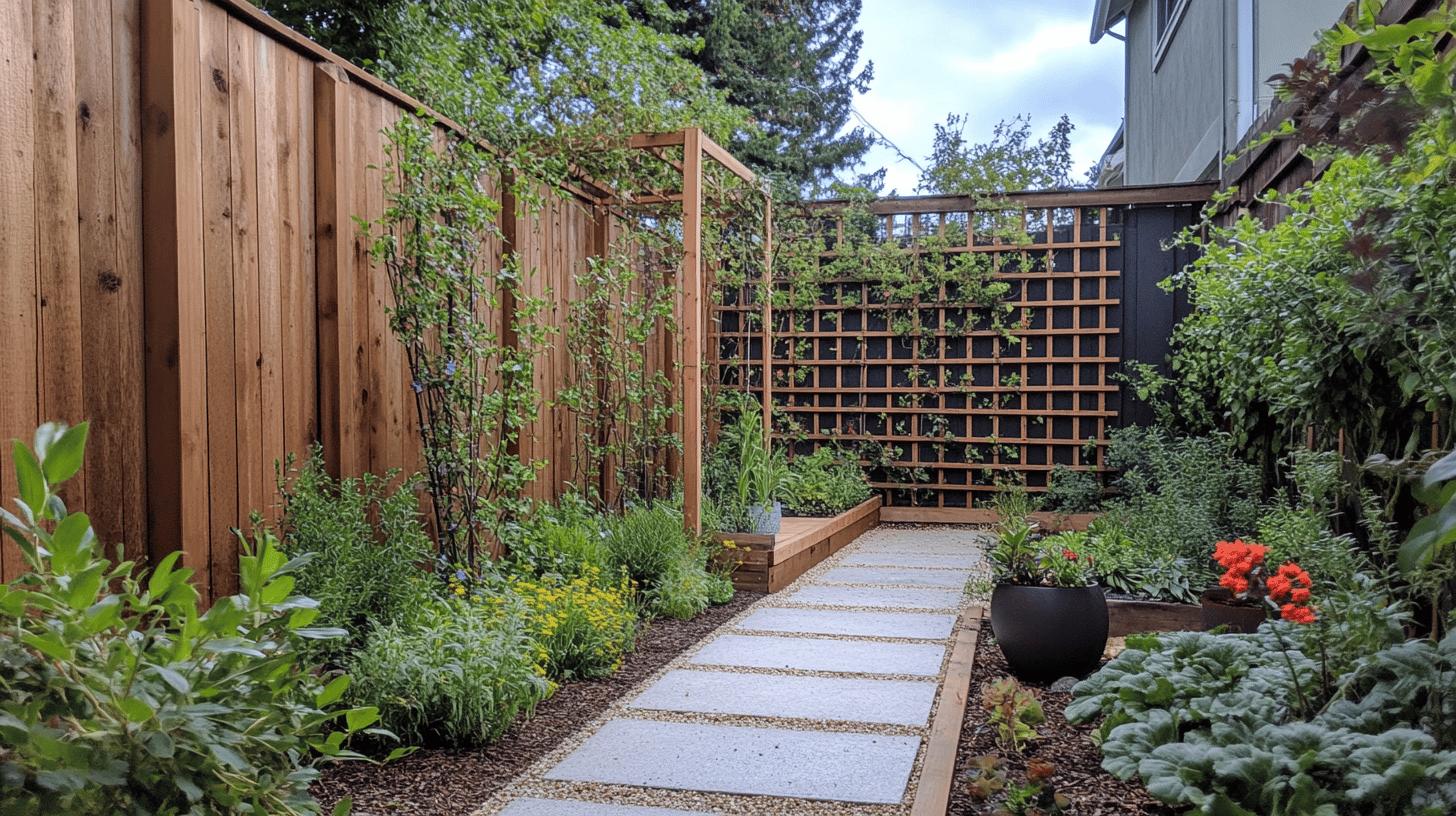
Small backyards often present unique challenges, but the right trellis design can make a world of difference. Limited space can feel confining, but by strategically incorporating trellises, you can add visual interest and functionality without overwhelming the area. These structures allow you to utilize vertical space, creating an illusion of depth and openness. A well-placed trellis can turn a narrow side yard into a cozy, inviting nook, offering a perfect blend of beauty and practicality.
- Use Vertical Elements: Install tall trellises to draw the eye upwards, adding height and dimension to small spaces.
- Incorporate Gates: Combine trellises with gates to define areas and create charming entries that add character.
- Select Climbing Plants: Choose compact, fast-growing climbers that provide coverage without taking up ground space.
- Opt for Lattice Panels: These can provide privacy and support for vines, enhancing the sense of seclusion in tight areas.
- Create Living Walls: Use trellises to support a variety of plants, forming lush, green walls that maximize space usage.
Trellises have a transformative effect on small areas, offering a seamless way to enhance both aesthetics and functionality. By leveraging these designs, you can overcome the limitations of compact spaces, creating a backyard that feels open, inviting, and full of life. Whether it’s a narrow passage or a petite patio, trellises provide the perfect solution to make the most of every inch.
Enhancing Backyard Privacy with Trellises
In our quest for a personal haven in the backyard, privacy is often a top priority. Whether you’re enjoying a quiet morning coffee or hosting an intimate gathering, having a secluded outdoor space can significantly enhance your comfort and enjoyment. Trellises offer an elegant and effective solution for enhancing backyard privacy. By incorporating these structures into your garden design, you can create a sense of enclosure while maintaining an open and inviting atmosphere. The right trellis can transform your backyard into a private retreat, shielding you from prying eyes without sacrificing aesthetics.
- Train dense vines like ivy or clematis on trellises to form a lush, natural curtain that provides year-round coverage.
- Install lattice panels as privacy screens, allowing light and air to pass through while obstructing direct views.
- Use trellises to support fast-growing plants such as bamboo or tall grasses, which can quickly create a dense privacy barrier.
- Combine trellises with existing fences, enhancing their height and texture with climbing plants for added seclusion.
These methods not only increase privacy but also add visual interest to your backyard. By using trellises strategically, you can create various zones within your outdoor space, each with its own level of intimacy. The beauty of privacy-enhancing trellises lies in their ability to balance openness with seclusion, crafting a serene environment where you can relax and entertain with confidence.
Final Words
Exploring the world of arbor garden trellis options reveals their potential to elevate backyard aesthetics dramatically. From choosing the perfect design that suits your garden’s style to experimenting with bold and creative ideas, these structures can transform any outdoor space into an enchanting haven.
Embracing the DIY spirit, constructing your own trellis can be both rewarding and cost-effective. With climbing plants cascading gracefully, the trellis enhances beauty while providing privacy.
Regular maintenance ensures longevity, keeping your backyard a charming retreat. May your arbor garden trellis backyard dream beautifully bloom and grow!
FAQ
What is the difference between a trellis and an arbor?
A trellis and an arbor both support climbing plants, but a trellis is a flat framework often used against walls, while an arbor is an arch or structure, often creating a passageway.
Does an arbor need to be anchored?
Yes, an arbor should be anchored to prevent tipping over. This ensures stability, especially in windy conditions, and supports climbing plants effectively.
Where should I put my arbor in my garden?
Placing your arbor at an entrance or along a garden path can enhance both function and aesthetics, creating inviting entryways and defining garden spaces beautifully.
How do you secure a garden trellis in the ground?
To secure a garden trellis, drive sturdy stakes into the ground, attach the trellis with brackets, and reinforce it with concrete if necessary, for stability and long-term support.
What materials are best for a durable garden arbor?
For a durable garden arbor, consider materials like metal or pressure-treated wood, which withstand the elements well and require less frequent maintenance compared to softer woods.
Are DIY arbors a cost-effective option?
Yes, making a DIY arbor can be cost-effective. Using materials like metal cattle panels simplifies the process and reduces costs while providing sturdy support for plants.
What are some creative garden trellis ideas?
Creative garden trellis ideas include bold-colored arbors, decorative lattice patterns, arched garden paths, standalone arbors with columns, and trellises integrated with benches for both beauty and function.
